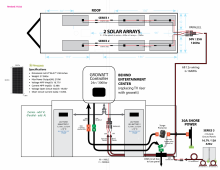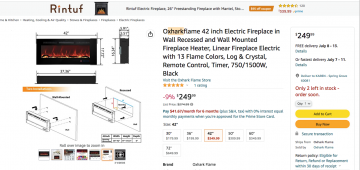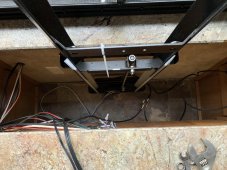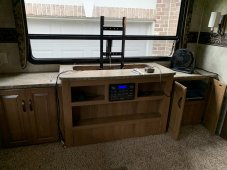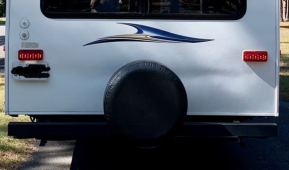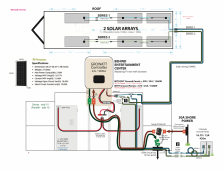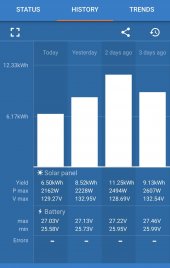Deek Johnson
New Member
- Joined
- Nov 17, 2021
- Messages
- 19
Hi all...finally getting around to finishing this project and working out the kinks. This is being installed in a 35' Keystone 395RE trailer with a rear living floor plan.
1. The plan is to remove the hidden TV in the entertainment cabinet at the back of the RV and replace with the Growatt controller (will raise up and down to hide like TV does). Lots more wasted space in there so got 2 BigBattery Hawk batteries to fit. My son is helping who lives/works on the road full time in trailer and has put in a few systems for himself. We're thinking I'll probably need some switches/fuses but this is what we have so far. Would appreciate your comments.
2. The overall plan is to redirect the shore power cable to run directly into the growatt, and then the growatt output would reconnect back into the OEM circuit box on the floor that then feeds the fuse panel. The Growatt would manage all incoming/outgoing energy (shore power and solar/to charge batteries/energy draw from battery or shore, etc).
3. Also trying to set it up so I can easily bypass the Growatt/solar system (if something should go wrong that I can't fix right away) by simply unplugging the incoming shore power back into the OEM circuit box.
4. A few questions remain regarding not having equal length wires between panels, as I had to mount 2 panels further forward on roof...does it matter?
5. Does running ground panels and roof panels w different voltages together into parallel circuit cause an issue...will only be using ground panels if I have to (sitting in shade or extra cloudy)?
Anything else you folks can see please feel free to comment. Good news so far is I don't think I have any suicide cables!!!
Thx for your help
Deek
1. The plan is to remove the hidden TV in the entertainment cabinet at the back of the RV and replace with the Growatt controller (will raise up and down to hide like TV does). Lots more wasted space in there so got 2 BigBattery Hawk batteries to fit. My son is helping who lives/works on the road full time in trailer and has put in a few systems for himself. We're thinking I'll probably need some switches/fuses but this is what we have so far. Would appreciate your comments.
2. The overall plan is to redirect the shore power cable to run directly into the growatt, and then the growatt output would reconnect back into the OEM circuit box on the floor that then feeds the fuse panel. The Growatt would manage all incoming/outgoing energy (shore power and solar/to charge batteries/energy draw from battery or shore, etc).
3. Also trying to set it up so I can easily bypass the Growatt/solar system (if something should go wrong that I can't fix right away) by simply unplugging the incoming shore power back into the OEM circuit box.
4. A few questions remain regarding not having equal length wires between panels, as I had to mount 2 panels further forward on roof...does it matter?
5. Does running ground panels and roof panels w different voltages together into parallel circuit cause an issue...will only be using ground panels if I have to (sitting in shade or extra cloudy)?
Anything else you folks can see please feel free to comment. Good news so far is I don't think I have any suicide cables!!!
Thx for your help
Deek



